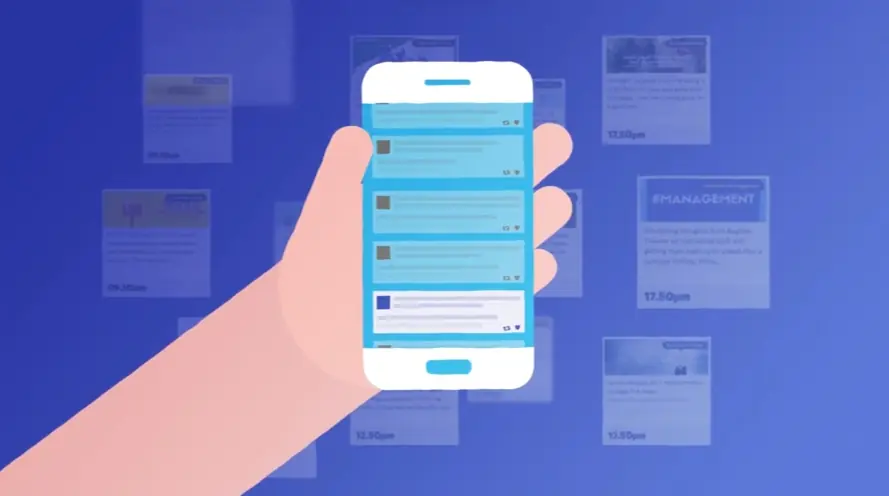
How can an app onboarding video showcase key features to boost user engagement?
Showcase key features with dynamic animations and clear narration, highlighting benefits and ease of use. Focus on intuitive design and seamless user experience.
What content should an app onboarding video include to improve user retention?
Include a concise overview of core functionalities, key benefits, and a clear call to action. Motivate users to explore the app and integrate it into their routines.
How do successful apps use onboarding videos to reduce user churn?
Address user pain points directly, showcasing solutions and building excitement. Encourage continued use and minimize drop-off by demonstrating value.
What storytelling techniques make onboarding videos more compelling?
Craft compelling narratives focused on user needs, presenting the app as a solution. Highlight positive outcomes, creating an emotional connection.
How can existing brand assets be repurposed for app onboarding videos?
Seamlessly integrate existing logos, color palettes, and brand messaging. Maintain visual consistency and reinforce brand recognition for a cohesive experience.
What video style best introduces a complex app's functionality?
Use a clear, concise style with step-by-step instructions and visual cues. Effectively introduce complex functionalities, minimizing user confusion.
How long should an app onboarding video be to maximize user comprehension?
Aim for under 60 seconds to maintain user attention and deliver key information efficiently. Concise videos maximize comprehension and minimize drop-off.
What are common mistakes to avoid when producing an app onboarding video?
Avoid overwhelming users with excessive information or technical jargon. Focus on core functionalities and benefits, keeping the message clear and concise.
How can accessibility best practices be applied to app onboarding videos?
Incorporate captions, transcripts, and audio descriptions for accessibility. Promote inclusivity and maximize reach for users with disabilities.
How can sound design enhance an app onboarding video's effectiveness?
Carefully select music and sound effects to enhance engagement and reinforce key messages. Create a more immersive and memorable experience.
How can animation highlight key features in an app onboarding video?
Use animation to highlight key features, UI elements, and user flows. Make complex functionalities easier to understand and promote user exploration.
How can user testimonials build trust in an app onboarding experience?
Incorporate positive user testimonials to build trust and credibility. Showcase real-world benefits and encourage new users to adopt the app.
How can an onboarding video clearly communicate an app's value proposition?
Clearly articulate the app's unique selling points and how it solves user problems. Create a compelling reason to download and engage with the app.
How does an app onboarding video reinforce brand identity?
Use brand elements, messaging, and visual style consistently to reinforce brand identity. Create a cohesive user experience and strengthen brand recognition.
What are the crucial steps in producing a professional app onboarding video?
Crucial production steps include needs analysis, script development, storyboarding, asset production, animation/editing, review/feedback, and final delivery. Typical turnaround is 3-8 weeks, with pricing ranging from $1000-$6000 depending on complexity.
Boosting App Retention with Video Onboarding
isn't just about introducing features it is a strategic investment enhancing long term user retention. The initial moments users spend within an application are critical shaping their decision whether to stay or abandon. A well crafted App Onboarding Video serves as a powerful tool in this regard guiding users seamlessly from download to their "aha moment" where they truly grasp the application's value and potential. This early understanding creates crucial positive associations fostering familiarity comfort immediate engagement.
Effective video onboarding works because it meets users where they are offering easily digestible visual information preferred over dense text. Quickly highlighting the clear value proposition and solving initial pain points within a short format like under sixty seconds captures shrinking attention spans effectively. Crafting a positive first impression builds confidence trust encouraging deeper exploration. Furthermore storytelling through relatable scenarios or showcasing how real people benefit creates an emotional connection making the journey more memorable personal.
Beyond the initial welcome video can support users throughout their early interactions. Tailoring content to specific user needs enhances relevance while integrating accessibility features like captions and audio descriptions ensures inclusivity for everyone. Showing key functions via engaging screen recordings or simplifying complex steps with strategic animation reduces confusion friction. The goal remains empowering users enabling them to utilize core features quickly confidently setting the stage for continued app usage.
Integrate interactive elements or gamification within videos motivating task completion journey progress.
Showcase immediate benefits or access to premium features during onboarding creating a positive memorable peak experience.
Utilize analytics to gain insights on video effectiveness user behavior continuously optimizing content approach.
Embed short micro-videos within tooltips or empty states providing contextual help exactly when users need it.
Ultimately investing in high quality video onboarding significantly increases the likelihood users become long term advocates positively impacting overall app success.
Why Advids for App Onboarding Video?
At Advids, we create exceptional App Onboarding Videos that drive results. Our blend of creative storytelling, advanced technology, and proven experience ensures your vision translates into compelling animation that effectively onboards your users.
Transforming Ideas into Engaging App Onboarding Experiences:
Customized App Onboarding Video Solutions: We tailor explainer videos, character animations, and other App Onboarding Video formats to your brand, style, and target audience.
Creative Storytelling Through Animation: Our animators and storytellers craft captivating narratives that engage viewers and encourage in-app exploration.
Cutting-Edge App Onboarding Video Technology: We use industry-leading software and techniques to create visually stunning videos that leave a lasting impact, guiding users seamlessly through your app's features.
A Legacy of Success in Video Production:
12+ Years of Proven Success: With over 3400 successful projects across various video formats, we possess a deep understanding of effective video production, including over 270 successful App Onboarding Videos.
Trusted by Industry Leaders: From startups to Fortune 500 companies—Razorpay, Ola, Mercedes, the United Nations, Continental, and Mercer—trust us to bring their stories to life.
Client Satisfaction Guaranteed: Our commitment to excellence is reflected in over 109 five-star Google reviews, showcasing our talent, creativity, and dedication to client satisfaction.
A Partnership Built on Collaboration and Communication:
Collaborative Process: We work closely with you from concept to completion, ensuring your vision is realized in the final animation.
Strategic Communication: We prioritize understanding your needs, target audience, and brand identity to create impactful App Onboarding Videos that resonate with users and drive adoption.
Ready to unlock the potential of App Onboarding Video for your business with the latest video design trends of 2024? Let Advids be your trusted partner in transforming your ideas into engaging and effective animated experiences.
Checkout some of the projects and work our team at Advids has been producing:
What is a App Onboarding Video?
An app onboarding video is a short, engaging video that introduces new users to your app, explains its key features and functionalities, and guides them through the initial setup process. It's like a friendly guide that helps users quickly understand the value of your app and how to get started.
App onboarding videos are used to improve user engagement , retention, and overall app success. They provide a positive first impression , educate users about the app's value, and guide them through the initial setup process, enhancing user adoption and satisfaction.
What do top App Onboarding Videos have in common?
Craft compelling app onboarding video s that resonate with your target audience and drive conversions.
Clear Value Proposition - Emphasize the app's unique selling proposition within the first few seconds. Focus on the "why" behind the app.
What makes App Onboarding Video effective?
A compelling app onboarding video is a crucial element in the success of any app. It is a strategic design to guide users through the initial stages of app usage, ensuring a smooth and engaging experience.
Conversational and informative, app onboarding videos aim to create a positive first impression, educate users about the app's value, and encourage them to explore its features. They are driven by a clear understanding of the target audience and their needs, ensuring that the information presented is relevant and engaging.
Methods for creating effective app onboarding videos include using a clear and concise narrative, incorporating visual elements that capture attention, and providing a clear call to action. The goal is to create a video that is both informative and entertaining, leaving users with a positive impression of the app and a desire to explore its features further.
How long should your App Onboarding Video be?
Optimize app onboarding video length for maximum impact by aligning video type, content, and user journey stage .
pre-production considerations for Determining Video Length:
App onboarding video length guide
| App Onboarding Types | Video Length | Use Case | Funnel |
|---|
| Explainer Video | 45-60 seconds | Clearly communicates app value proposition and core features using concise narration and engaging visuals, possibly with a minimalist style animation | Awareness |
| Animated Screen Recording | 30-45 seconds | Showcases app's key functionalities through a visually appealing animated walkthrough, highlighting user interaction and benefits | Consideration |
| Tutorial Video | 1-2 minutes | Guides users through specific tasks or features, using clear instructions and on-screen prompts, potentially employing a hand-drawn style for a friendly feel | Conversion |
| Walkthrough Video | 1-1.5 minutes | Provides a comprehensive overview of the app's interface and navigation, emphasizing ease of use with a live-action screen recording | Engagement |
| Product Demo | 1.5-2 minutes | Demonstrates the app's capabilities and benefits through a live demonstration, showcasing real-world scenarios and user interactions, possibly using a cinematic style for a professional look | Retention |
How to create App Onboarding Videos?
Crafting compelling app onboarding videos requires a strategic approach that prioritizes user experience and clear communication . Mastering these key phases ensures your video effectively guides users and drives app adoption .
* Define Purpose - Focus on a single, measurable objective , like increased app downloads or feature adoption.- Target Audience - Create user personas to tailor the video's tone, style, and messaging.
- Scriptwriting - Use clear, concise language, focusing on user benefits and pain point solutions.
- Storyboarding - Employ a clear visual hierarchy to guide the viewer's eye and highlight key interactions.
- Visual Selection - Use high-quality, on-brand visuals that are consistent with the app's design language.
- Video Recording - Use professional equipment and lighting to create a polished and engaging visual experience.
- Video Editing - Implement smooth transitions and dynamic pacing to maintain viewer interest.
- Sound Design - Use music and sound effects to create emotional resonance and emphasize key actions .
- platform optimization - Adapt the video's resolution and format to suit different devices and screen sizes.
- Video Publishing - Utilize A/B testing to optimize video performance and maximize engagement.
Author & Editor Bio
A video producer with a passion for creating compelling video narratives, Jai Ghosh brings a wealth of experience to his role. His background in Digital Journalism and over 11 years of freelance media consulting inform his approach to video production. For the past 7 years, he has been a vital part of the Advids team, honing his expertise in video content planning, creation, and strategy.
His collaborative approach ensures that he works closely with clients, from startups to enterprises, to understand their communication goals and deliver impactful video solutions. He thrives on transforming ideas into engaging videos, whether it's a product demo, an educational explainer, or a brand story.
An avid reader of modern marketing literature, he keeps his knowledge current. Among his favorite reads from 2024 are "Balls Out Marketing" by Peter Roesler, "Give to Grow" by Mo Bunnell and "For the Culture" by Marcus Collins. His results-driven approach ensures that video content resonates with audiences and helps businesses flourish.


